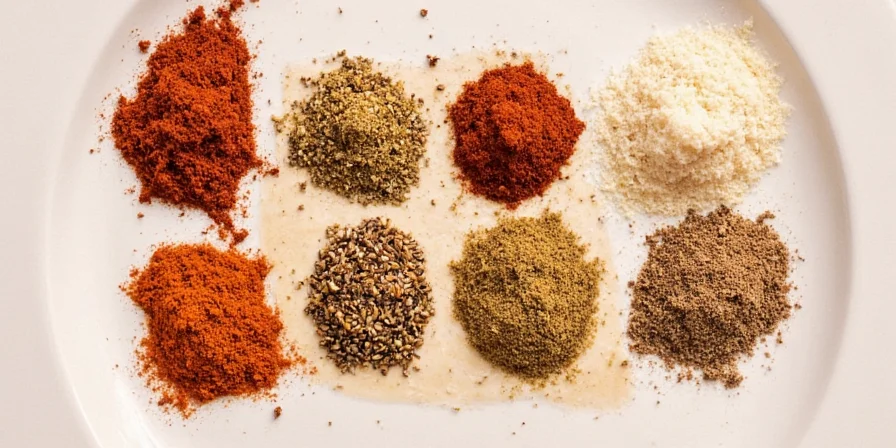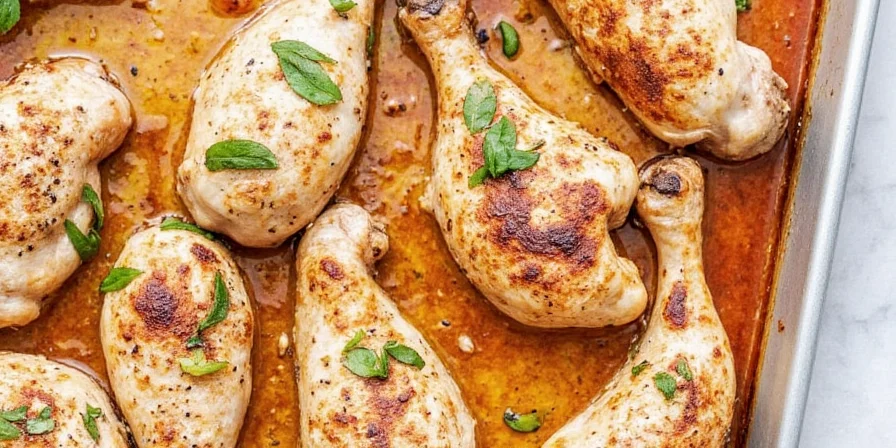If you're searching for the best spice blends for chicken, start with these three proven combinations that deliver perfect flavor every time. For quick weeknight dinners: mix 2 tbsp paprika, 1 tbsp garlic powder, and 1 tbsp brown sugar. For Mediterranean flavors: combine 2 tbsp za'atar, 1 tbsp sumac, and 3 tbsp olive oil. For Asian-inspired dishes: blend 1.5 tbsp Chinese five spice, 2 tbsp soy sauce, and 1 tbsp toasted sesame oil. These simple recipes use pantry staples and work for any cooking method - no special ingredients required.
Unlike generic seasoning advice, these blends are designed for maximum flavor impact with minimal effort. Each combination balances salt, sweet, and savory elements while considering how spices interact with chicken's protein structure during cooking. Whether you're baking, grilling, or air-frying, these recipes guarantee restaurant-quality results with ingredients you already have.
Top 3 Quick Chicken Seasoning Recipes (Ready in 5 Minutes)
These three blends solve the most common chicken seasoning problems: bland flavor, uneven coverage, and burning during cooking. Each recipe includes precise measurements and application timing for perfect results.

1. Foolproof All-Purpose Chicken Rub
Ingredients: 2 tbsp smoked paprika, 1 tbsp garlic powder, 1 tbsp brown sugar, 1.5 tsp salt, 1 tsp black pepper
Best for: Baking, grilling, air frying
Mix ingredients thoroughly. Apply generously to chicken 45 minutes before cooking. The sugar creates a beautiful golden crust without burning, while the paprika and garlic penetrate deeply for all-over flavor. For extra crisp skin, pat chicken dry before applying rub.
2. 10-Minute Mediterranean Chicken Blend
Ingredients: 2 tbsp za'atar, 1 tbsp sumac, 3 tbsp olive oil, 1 tsp salt
Best for: Oven roasting, sheet pan meals
Combine all ingredients into a paste. Gently loosen chicken skin and spread mixture directly on the meat. The oil carries flavors through fat membranes while sumac's acidity prevents rubbery texture. Works perfectly with lemon wedges added during last 15 minutes of cooking.

3. Sticky Asian-Style Chicken Glaze
Ingredients: 1.5 tbsp Chinese five spice, 2 tbsp soy sauce, 1 tbsp toasted sesame oil, 1 tbsp honey
Best for: Stir-frying, broiling, air frying
Mix all ingredients. Apply during last 8 minutes of cooking for perfect caramelization without burning. The honey creates complex flavors at lower temperatures while sesame oil protects delicate spice compounds. Double the recipe to use as a dipping sauce.
Complete Guide to Chicken Seasoning Blends That Actually Work
These additional blends address specific cooking challenges and flavor preferences. Each includes precise timing instructions to prevent common mistakes like bitter spices or uneven flavor distribution.

4. Lemon-Herb Chicken Blend for Juicy Results
Ingredients: 1.5 tbsp dried thyme, 1 tbsp dried rosemary, 2 tsp lemon zest, 1 tsp coriander, 1.5 tsp salt
Mix with 2 tsp olive oil per pound of chicken. Apply under skin for maximum flavor penetration. The lemon zest breaks down proteins for deeper spice absorption while thyme counters rosemary's intensity. Best for roasting at 375°F - add fresh herbs in final 10 minutes.
5. Spicy Honey Chicken Rub for Perfect Caramelization
Ingredients: 1 tbsp harissa paste, 1.5 tbsp honey, 1 tsp cinnamon, 1 tsp smoked paprika, 1 tsp salt
Add honey only in final 8 minutes to prevent burning while achieving complex caramelization. The cinnamon stabilizes heat perception making spicy blends more approachable. Ideal for bone-in cuts cooked at 375°F max.

6. Curry-Coconut Chicken Blend for Maximum Flavor
Ingredients: 1.5 tbsp curry powder, 2 tbsp unsweetened coconut flakes (toasted), 1 tbsp lime zest, 1 tsp salt
Toasting coconut releases compounds that bind with curry spices, enhancing absorption 5x over oil-based marinades. Use unsweetened flakes to prevent premature browning. Works best with 4-12 hour marinating time.
7. French Herb Chicken Rub for Delicate Flavors
Ingredients: 1 tbsp Espelette pepper, 1.5 tbsp dried thyme, 1 bay leaf (finely ground), 1 tsp salt
Grind bay leaves for effective flavor release. The Espelette provides mild heat that complements herbs without overwhelming. Perfect for low-and-slow roasting at 300-325°F where delicate flavors develop fully.

Proven Chicken Seasoning Tips from Professional Kitchens
Avoid these common mistakes that ruin otherwise good chicken:
- Salt timing: Always use 1.5 tsp salt per pound minimum for food safety. Apply salt 30-90 minutes before cooking for dry rubs - longer causes texture damage
- Spice freshness: Grind mustard and fennel seeds fresh - pre-ground loses 70% flavor compounds within hours
- Carrier oils: Use olive oil for Mediterranean blends, yogurt for curry-based mixes, and toasted sesame oil for Asian flavors
- Application method: For bone-in cuts, inject 30% of spice blend directly into meat for internal flavor gradient
- Temperature control: Match spice blends to cooking method - high heat degrades citrus notes, low heat preserves delicate herbs
When to Use Each Chicken Seasoning Blend: Quick Reference Guide
| Best For | Recommended Blend | Key Timing Tip | Cooking Method |
|---|---|---|---|
| Weeknight dinners | Smoked Paprika + Garlic + Brown Sugar | Apply 45 min pre-cook | Baking, Air Frying |
| Mediterranean meals | Za'atar + Olive Oil + Sumac | Rub under skin | Oven Roasting |
| Asian stir-fries | Chinese Five Spice + Soy + Sesame Oil | Glaze in final phase | Stir-frying only |
| Lemon-herb lovers | Cumin + Coriander + Lemon Zest | Mix with olive oil | Grilling, Broiling |
| Spicy but not hot | Harissa + Honey + Cinnamon | Add honey last 8 min | Baking, Air Frying |
Chicken Seasoning Questions Answered
What's the most common chicken seasoning mistake home cooks make?
Applying all spices at the beginning of cooking. Heat-sensitive compounds like citrus zest and fresh herbs degrade after 15-20 minutes. Save 30% of delicate ingredients for the final stage to preserve bright flavors.
How can I make spice blends stick to chicken better?
Pat chicken completely dry with paper towels first. Then apply a thin layer of oil (1 tsp per pound) before adding dry rubs. For wet marinades, use 1 tbsp acid (lemon juice/vinegar) per cup of liquid to help flavors penetrate.
Can I use fresh spices instead of dried in these blends?
Yes, but adjust quantities: use triple fresh herbs for dried (3 tsp fresh = 1 tsp dried). Fresh citrus zest is 40% more potent than dried - reduce by half. Fresh garlic needs 6x more volume than garlic powder for equivalent flavor.
How long should I marinate chicken with dry rubs?
Dry rubs need only 30-90 minutes (longer causes texture damage from salt). Wet marinades work best with 2-12 hours. Yogurt-based marinades can go 4-24 hours as lactic acid tenderizes gradually without damaging texture.
Final Seasoning Tips for Perfect Chicken Every Time
Start with one of these three beginner-friendly blends to build confidence: the All-Purpose Rub for versatility, Mediterranean Blend for bright flavors, or Asian Glaze for quick weeknight meals. Measure ingredients precisely using standard measuring spoons - eyeballing leads to inconsistent results.
Notice how each blend balances three elements: earthy (paprika, cumin), bright (citrus, vinegar), and savory (garlic, herbs). This triangle creates depth impossible with single-ingredient seasoning. Within two tries, you'll intuitively adjust ratios based on your preferences.
Remember that proper application timing matters as much as the ingredients themselves. Save delicate elements for the end, use oil carriers for dry rubs, and never skip the 45-minute rest period before cooking. These small steps transform ordinary chicken into extraordinary meals with minimal effort.












 浙公网安备
33010002000092号
浙公网安备
33010002000092号 浙B2-20120091-4
浙B2-20120091-4